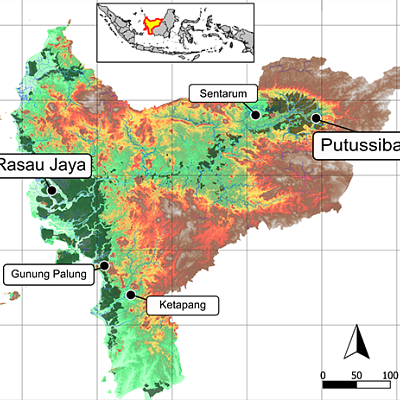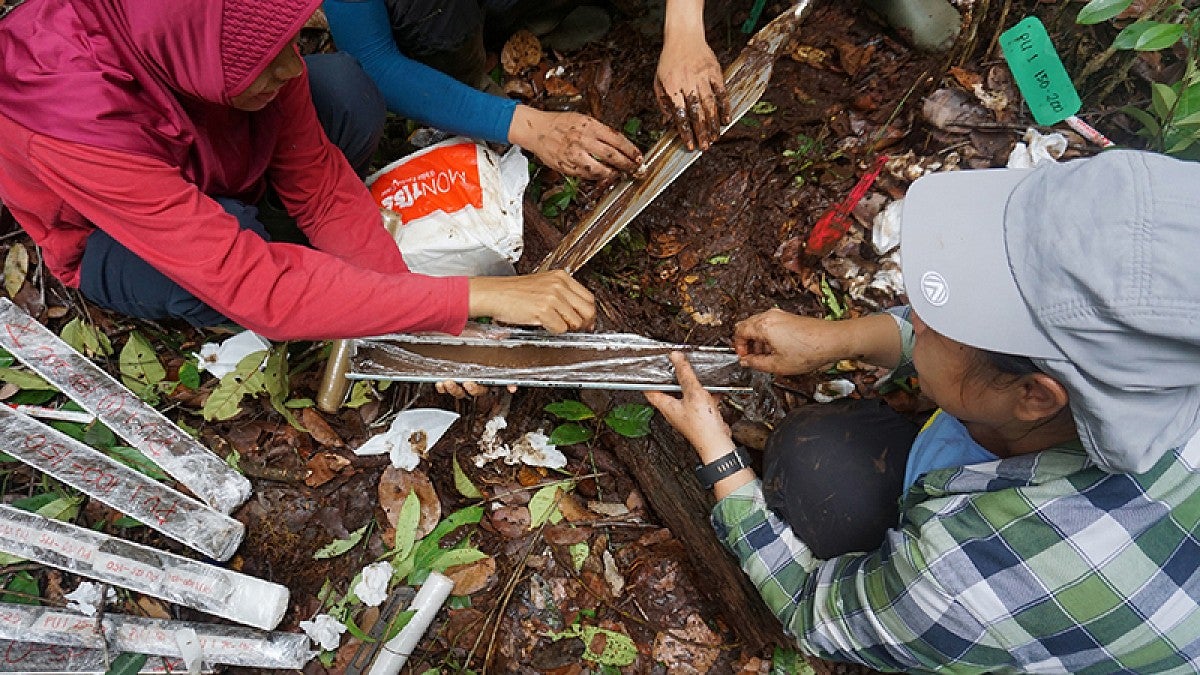A University of Oregon-led research team has identified tropical peatland in Indonesia that is twice as old and much deeper than previously thought.
The findings, published in Environmental Research Letters, provide new insights about the climate of equatorial rainforests, especially during the last ice age, said study co-author Dan Gavin, a professor of in the Department of Geography.
At an inland site on Borneo, near the northern city of Putussibau, researchers found peatland that formed at least 47,800 years ago, according to radiocarbon dating. The site is 18 meters deep, roughly the height of a six-story building.

“We studied peatland, a type of soil that is made of organic matter such as wood and leaves,” said Monika Ruwaimana, a UO doctoral student and lecturer at Indonesia’s Universitas Atma Jaya Yogyakarta.
“This dead plant material preserves well in the soil and keeps building up because a high water table prevents decay,” she said. “Usually the peatland only reaches few meters depth, but the peatland we found went much deeper.”
The site suggests that the region remained sufficiently wet and warm to support peat growth through the last ice age, Gavin said.
“The climate during that time is still poorly understood as there are few places in the very-wet tropics, where there is no dry season, that have such long sediment archives,” he said.
The Putussibau site has been not been as disturbed by deforestation and the conversion of land to agriculture as most other areas of Indonesia, noted Ruwaimana, who was the study’s lead author.
“We thought the Putussibau site would be thinner because people had already built roads over it,” she said. “But surprisingly we found depths of 17 to 18 meters. As comparison, the average peat depth in Indonesia is 5 to 6 meters.”
The coastal sites contain shallower peatland that didn’t begin forming until after the last ice age and after sea level stabilized between 4,000 and 7,000 years ago.
The inland sites, the researchers wrote, may be the oldest tropical peats and contain the largest density of carbon in the world but are increasingly being threatened by changes in land use.
“The inland peat possibly played an important role in climate and carbon storage before and during the last ice age,” Ruwaimana said.
During that glaciation, she noted, atmospheric carbon dioxide was much lower, and previous evidence suggested that much of the region’s carbon had moved into the oceans. The new findings, however, show inland peatlands persisted.
Across the sites, 37 radiocarbon dates were obtained. During a cool, dry period 20,000-30,000 years ago, Ruwaimana said, the new dating indicated a hiatus of peatland formation when synthesized with previous research across Indonesia.
“The ages provide a clearer picture on its formation history and how it connects to the past climate,” she said. “As this peat forms layer by layer like a pancake layer cake, each layer tells us the story about fire, plant and climate when that layer was formed.”
With the revised depths of inland peatlands, the researchers suggest that previous estimates of carbon storage, 25.3 gigatons across Indonesia and 9.1 gigatons on Borneo, are too low. However, Ruwaimana said, more data is needed for accurate calculations.
The project is continuing, Gavin said. The team is extracting pollen, charcoal and humic acid from the cores in hopes of learning what kinds of plants existed before the ice age and about precipitation changes.
Peatlands store a lot of organic carbon and play an important role in the carbon cycle, Ruwaimana said. Recent published work by a team that included UO geologist Estelle Chaussard, she noted, showed that peat loss and degradation have made Indonesia a major source of carbon dioxide.
Ruwaimana will discuss a portion of her findings as part of a presentation on peatland dynamics, disturbances and restoration, organized by Chaussard, during the American Geophysical Society’s fall meeting in December. The meeting, the largest worldwide conference in the earth and space sciences, will be conducted virtually this year.
“Burning peatlands is not good idea,” Ruwaimana said. “It makes toxic smoke, lowers the water table and releases a lot of carbon. The fire that lasted two months in 1997 made Indonesia the No. 1 carbon emitter that year. The 2015 fire caused upper respiratory infections in a half million people and shut down airports across Southeast Asia.”
Lucas Silva, a professor of geography and head of the UO’s Soil Plant Atmosphere research lab, also was a co-author on the study, along with Gusti Z. Anshari of the Universitas Tanjungpura in Pontianak, Indonesia.
The National Science Foundation supported the research. Ruwaimana’s doctoral studies at the UO are supported by a Fulbright scholarship through the American Indonesian Exchange Foundation and a travel grant from the American Indonesian Cultural & Educational Foundation.
—By Jim Barlow, University Communications


